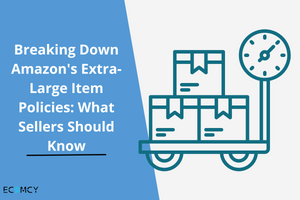Breaking Down Amazon's Extra-Large Item Policies: What Sellers Should Know
May 06, 2024

Navigating the labyrinth of policies and guidelines can feel like deciphering ancient scrolls as an Amazon seller. One particularly complex area is handling extra-large items. Understanding Amazon's rules regarding oversized products is crucial for success, from shipping logistics to customer satisfaction. In this post, we'll dissect Amazon's extra-large item policies to equip sellers with the knowledge they need to thrive in this space.
What Qualifies as an Extra-Large Item?
Dimensional Threshold
- An item is typically considered extra-large if any dimension (length, width, or height) exceeds a certain threshold.
- Standard benchmark: 18 inches for any single dimension.
- Examples: A television with a screen size larger than 18 inches diagonally, a piece of furniture taller than 18 inches, or a bulky appliance wider than 18 inches.
Weight Threshold
- Amazon also considers the total weight of the package when determining whether it falls into the extra-large category.
- General rule: If the total weight of the package exceeds 20 pounds, it may be classified as an extra-large item.
- Examples: Heavy gym equipment, a large kitchen appliance, or a bulky electronic device weighing over 20 pounds.
Understanding these dimensional and weight thresholds is crucial for sellers dealing with oversized products on Amazon. It enables accurate categorization, appropriate pricing and shipping strategies, and effective management of inventory and fulfillment processes.
Shipping and Fulfillment Challenges for Oversized Items
Shipping oversized items entails unique challenges that differentiate them from standard-sized products. These challenges primarily revolve around packaging, shipping costs, and the operational capabilities of Amazon's fulfillment centers. Here's an in-depth exploration of these challenges:
Specialized Packaging Requirements
- Oversized items often require unique packaging materials to protect them adequately during transit.
- Packaging materials must be robust enough to withstand the rigors of shipping and handling, especially for bulky and heavy items prone to damage.
- Customized packaging solutions may be necessary to accommodate the size and shape of the item while maintaining its integrity.
Higher Shipping Costs
- Shipping oversized items typically incurs higher transportation costs compared to standard-sized products.
- The package's dimensional weight, along with its actual weight, influences shipping rates, leading to increased expenses.
- Carriers may impose additional surcharges for handling oversized packages, further adding to the overall shipping costs.
Operational Considerations at Fulfillment Centers
- Amazon's fulfillment centers must have the necessary infrastructure and resources to handle oversized items efficiently.
- Allocating storage space becomes crucial, as oversized products occupy more volume than standard-sized items, potentially impacting overall warehouse capacity.
- Fulfillment processes, including picking, packing, and shipping, may require modifications to accommodate the size and weight of oversized items, ensuring smooth operations.
Logistical Complexities
- Coordinating the transportation of oversized items from the seller's location to Amazon's fulfillment centers can be logistically challenging.
- Sellers may need to engage specialized freight carriers capable of transporting bulky items safely and efficiently.
- Optimizing shipping routes and delivery schedules becomes essential to minimize transit times and reduce the risk of delays or damages during transportation.
Cost Management and Profitability
- To maintain profitability, sellers must carefully evaluate the additional costs associated with shipping and fulfillment of oversized items.
- Pricing strategies should factor in higher shipping expenses, specialized packaging materials, and any applicable fulfillment fees imposed by Amazon.
- Balancing competitive pricing with the need to cover expenses and generate profit margins is crucial for long-term sustainability in the oversized item market.
Customer Experience and Returns
Ensuring a positive customer experience is paramount for any seller on Amazon. However, with extra-large items, this becomes even more crucial. Customers purchasing oversized products expect hassle-free delivery and may be more prone to dissatisfaction if their expectations aren't met. Additionally, returns for these items can be more complicated and costly due to their size and weight. Sellers must have clear return policies and be prepared to handle return logistics efficiently.
Amazon's Fees and Regulations
Amazon imposes specific fees and regulations for selling extra-large items on its platform. For instance, sellers may incur higher referral fees for oversized products than standard-sized ones. Additionally, strict guidelines concerning packaging and labeling requirements for these items are established. Failure to adhere to these regulations can result in penalties or account suspension.
Strategies for Success in Selling Extra-Large Items on Amazon
Selling extra-large items on Amazon presents unique opportunities for profitability, but it requires a strategic approach to overcome challenges and maximize success. Here are comprehensive strategies to thrive in this niche market:
Optimize Product Listings
- Craft detailed product descriptions highlighting the extra-large items' features, dimensions, and specifications.
- Use high-quality images from multiple angles to give customers a clear visual representation of the product, including its size and scale.
-
Utilize keywords relevant to the product category and target audience to improve visibility in Amazon search results.
Invest in Sturdy Packaging Materials
- Prioritize using durable and protective packaging materials to withstand the unique challenges of shipping oversized items.
- Custom-fit packaging solutions may be necessary to transport large, heavy, or irregularly shaped products safely.
- Consider branding opportunities by incorporating custom packaging or labels that reinforce your brand identity and enhance customers' unboxing experience.
Offer Competitive Shipping Rates and Options
- Research and negotiate competitive shipping rates with carriers, considering the extra-large items' size, weight, and destination.
- Provide customers with a range of shipping options, including standard, expedited, and freight services, to accommodate their preferences and urgency.
- Communicate shipping costs and delivery timelines upfront to manage customer expectations and reduce cart abandonment rates.
Monitor Inventory Levels and Demand
- Implement robust inventory management systems to track stock levels and sales performance of extra-large items in real-time.
- Forecast demand trends based on historical sales data, seasonality, and market trends to optimize inventory replenishment and avoid stockouts.
- Strategically adjust pricing, promotions, and marketing efforts to stimulate demand and minimize excess inventory holding costs.
Deliver Excellent Customer Service
- Provide responsive and personalized customer support to address inquiries, resolve issues, and enhance the shopping experience.
- Proactively communicate with customers throughout the order fulfillment process, including order confirmation, shipping updates, and post-purchase follow-ups.
- Implement hassle-free return and exchange policies for extra-large items, demonstrating confidence in product quality and customer satisfaction.
Conclusion
Navigating Amazon's extra-large item policies requires careful attention to detail and a proactive approach to customer satisfaction. By understanding the platform's rules and regulations, sellers can mitigate risks and maximize their opportunities in this niche market. With the right strategies, selling oversized products on Amazon can be a profitable venture for savvy entrepreneurs.
Leave a comment
Comments will be approved before showing up.




